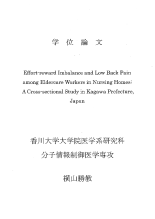Effort-reward Imbalance and Low Back Pain among Eldercare Workers in Nursing Homes : A Cross-sectional Study in Kagawa Prefecture, Japan
この論文にアクセスする
著者
書誌事項
- タイトル
-
Effort-reward Imbalance and Low Back Pain among Eldercare Workers in Nursing Homes : A Cross-sectional Study in Kagawa Prefecture, Japan
- 著者名
-
横山, 勝教
- 学位授与大学
-
香川大学
- 取得学位
-
博士(医学)
- 学位授与番号
-
甲第661号
- 学位授与年月日
-
2017-03-24
注記・抄録
ObjectivesTo clarify effort‐reward imbalance among eldercare workers in nursing homes and to examine the association between the effort‐reward imbalance (ERI) and low back pain (LBP) among them.
MethodsA total of 549 questionnaires were distributed to a random sample comprising 23% of the 79 special elderly nursing homes in Kagawa in 2013. A total of 467 eldercare workers (response rate 85%) participated in this study. Of the 467 eligible respondents, 372 (80%) completed all items of the ERI questionnaire. Complete data were available for 342 (73%) eldercare workers.
ResultsOf the 342 respondents, 215 (63%) had LBP at the time of the study, and 291 (85%) showed a critical “high cost/low gain” condition as determined by an effort‐reward ratio >1. Multiple logistic regression analyses adjusted for age, gender, previous LBP experience, high‐risk work and K6 score showed that eldercare workers with a high ERI had a higher risk for LBP than workers with a low ERI (OR, 1.96; 95% CI, 1.02−3.77).
ConclusionsMost eldercare workers have a high ERI, and their LBP is associated with their ERI. Balancing effort and reward may be an important factor for improving LBP among eldercare workers in nursing homes.
10.1539/joh.13-0295-oa
Objectives To clarify effort‐reward imbalance among eldercare workers in nursing homes and to examine the association between the effort‐reward imbalance (ERI) and low back pain (LBP) among them.
Methods A total of 549 questionnaires were distributed to a random sample comprising 23% of the 79 special elderly nursing homes in Kagawa in 2013. A total of 467 eldercare workers (response rate 85%) participated in this study. Of the 467 eligible respondents, 372 (80%) completed all items of the ERI questionnaire. Complete data were available for 342 (73%) eldercare workers.
Results Of the 342 respondents, 215 (63%) had LBP at the time of the study, and 291 (85%) showed a critical “high cost/low gain” condition as determined by an effort‐reward ratio >1. Multiple logistic regression analyses adjusted for age, gender, previous LBP experience, high‐risk work and K6 score showed that eldercare workers with a high ERI had a higher risk for LBP than workers with a low ERI (OR, 1.96; 95% CI, 1.02−3.77).
Conclusions Most eldercare workers have a high ERI, and their LBP is associated with their ERI. Balancing effort and reward may be an important factor for improving LBP among eldercare workers in nursing homes.
目次
- 2017-12-12 再収集 (3コマ目)
